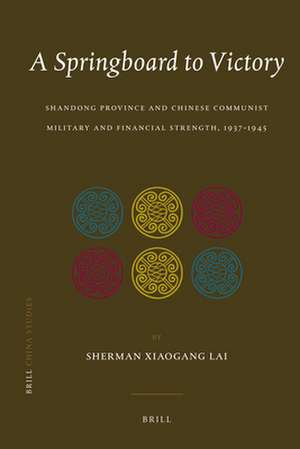A Springboard to Victory: Shandong Province and Chinese Communist Military and Financial Strength, 1937-1945: China Studies, cartea 19
Autor Sherman Xiaogang Laien Limba Engleză Hardback – 6 ian 2011
Din seria China Studies
- 18%
 Preț: 870.48 lei
Preț: 870.48 lei - 18%
 Preț: 744.18 lei
Preț: 744.18 lei - 18%
 Preț: 747.14 lei
Preț: 747.14 lei - 18%
 Preț: 906.95 lei
Preț: 906.95 lei - 18%
 Preț: 742.31 lei
Preț: 742.31 lei - 18%
 Preț: 742.63 lei
Preț: 742.63 lei - 18%
 Preț: 718.52 lei
Preț: 718.52 lei - 18%
 Preț: 795.61 lei
Preț: 795.61 lei - 18%
 Preț: 836.35 lei
Preț: 836.35 lei - 18%
 Preț: 868.23 lei
Preț: 868.23 lei - 18%
 Preț: 580.48 lei
Preț: 580.48 lei - 18%
 Preț: 867.85 lei
Preț: 867.85 lei -
 Preț: 372.63 lei
Preț: 372.63 lei - 18%
 Preț: 696.64 lei
Preț: 696.64 lei - 18%
 Preț: 999.97 lei
Preț: 999.97 lei - 18%
 Preț: 852.24 lei
Preț: 852.24 lei - 5%
 Preț: 279.17 lei
Preț: 279.17 lei - 18%
 Preț: 713.02 lei
Preț: 713.02 lei - 18%
 Preț: 867.45 lei
Preț: 867.45 lei - 18%
 Preț: 863.79 lei
Preț: 863.79 lei - 18%
 Preț: 676.64 lei
Preț: 676.64 lei - 18%
 Preț: 637.32 lei
Preț: 637.32 lei - 18%
 Preț: 587.10 lei
Preț: 587.10 lei - 18%
 Preț: 731.28 lei
Preț: 731.28 lei - 18%
 Preț: 851.39 lei
Preț: 851.39 lei - 18%
 Preț: 759.36 lei
Preț: 759.36 lei - 18%
 Preț: 1086.53 lei
Preț: 1086.53 lei - 18%
 Preț: 840.36 lei
Preț: 840.36 lei -
 Preț: 265.23 lei
Preț: 265.23 lei - 18%
 Preț: 738.96 lei
Preț: 738.96 lei - 18%
 Preț: 645.02 lei
Preț: 645.02 lei - 18%
 Preț: 615.35 lei
Preț: 615.35 lei - 18%
 Preț: 699.39 lei
Preț: 699.39 lei - 18%
 Preț: 699.39 lei
Preț: 699.39 lei - 15%
 Preț: 499.51 lei
Preț: 499.51 lei - 18%
 Preț: 638.79 lei
Preț: 638.79 lei - 18%
 Preț: 589.06 lei
Preț: 589.06 lei - 18%
 Preț: 557.52 lei
Preț: 557.52 lei - 18%
 Preț: 756.42 lei
Preț: 756.42 lei - 18%
 Preț: 615.35 lei
Preț: 615.35 lei - 18%
 Preț: 751.20 lei
Preț: 751.20 lei - 18%
 Preț: 702.77 lei
Preț: 702.77 lei - 18%
 Preț: 733.74 lei
Preț: 733.74 lei - 18%
 Preț: 710.93 lei
Preț: 710.93 lei - 18%
 Preț: 834.86 lei
Preț: 834.86 lei
Preț: 851.46 lei
Preț vechi: 1038.37 lei
-18% Nou
Puncte Express: 1277
Preț estimativ în valută:
162.92€ • 170.11$ • 134.84£
162.92€ • 170.11$ • 134.84£
Carte indisponibilă temporar
Doresc să fiu notificat când acest titlu va fi disponibil:
Se trimite...
Preluare comenzi: 021 569.72.76
Specificații
ISBN-13: 9789004198005
ISBN-10: 9004198008
Pagini: 344
Dimensiuni: 160 x 240 mm
Greutate: 0.68 kg
Editura: Brill
Colecția Brill
Seria China Studies
ISBN-10: 9004198008
Pagini: 344
Dimensiuni: 160 x 240 mm
Greutate: 0.68 kg
Editura: Brill
Colecția Brill
Seria China Studies
Notă biografică
Sherman Xiaogang Lai, Ph.D. (2008) in History, Queen’s University at Kingston, M.A. (2002) Royal Military College of Canada, is a Research Associate in the Leverhulme China’s War with Japan Programme, University of Oxford. He is a former officer of the Chinese army and served in China’s Vietnam War.
Recenzii
"Lai provides a pioneering account of the Communists' banking institutions in wartime Shandong."
Gregor Benton, Cardiff University, The Journal of Asian Studies, Vol. 71, No. 4 (November 2012)
"Lai understands the province in ways that only a native son can do. He creates a picture of the misery and despair of the wartime period, and of the desperate fight of much of the local population to get rid of a hated occupier...The kind of detailed, meticulous work that Lai has done, based on a deep familiarity with a region and the institution he is working on (Lai served in the People's Liberation Army) is a model for a deeper understanding of the complex and often contradictory process by which the CCP came to power."
Diana Lary, The University of British Columbia, Vancouver, Canada, Pacific Affairs Volume 86 No. 1 (March 2013)
Gregor Benton, Cardiff University, The Journal of Asian Studies, Vol. 71, No. 4 (November 2012)
"Lai understands the province in ways that only a native son can do. He creates a picture of the misery and despair of the wartime period, and of the desperate fight of much of the local population to get rid of a hated occupier...The kind of detailed, meticulous work that Lai has done, based on a deep familiarity with a region and the institution he is working on (Lai served in the People's Liberation Army) is a model for a deeper understanding of the complex and often contradictory process by which the CCP came to power."
Diana Lary, The University of British Columbia, Vancouver, Canada, Pacific Affairs Volume 86 No. 1 (March 2013)
Cuprins
Introduction
Chapter One: The Birth of the CCP Military-fiscal State in Shandong
Chapter Two: Moving Towards Confrontation
Chapter Three: Escalation and the CCP’s Financial Framework
Chapter Four: Institutions of Economic Control
Chapter Five: Pre-Pearl Harbor Policy Changes
Chapter Six: From the Strategies of Confrontation to Time-killing
Chapter Seven: Perseverance
Chapter Eight: Financial Pressure, Xu Muqiao and Salt
Chapter Nine: Turning Point and Encroachments
Chapter Ten: Accessing the Enemy’s Resources for Post-war Rivalry
Chapter Eleven: The Campaign to Reduce Rents and Interest Rates
Chapter Twelve: Conclusion
Chapter One: The Birth of the CCP Military-fiscal State in Shandong
Chapter Two: Moving Towards Confrontation
Chapter Three: Escalation and the CCP’s Financial Framework
Chapter Four: Institutions of Economic Control
Chapter Five: Pre-Pearl Harbor Policy Changes
Chapter Six: From the Strategies of Confrontation to Time-killing
Chapter Seven: Perseverance
Chapter Eight: Financial Pressure, Xu Muqiao and Salt
Chapter Nine: Turning Point and Encroachments
Chapter Ten: Accessing the Enemy’s Resources for Post-war Rivalry
Chapter Eleven: The Campaign to Reduce Rents and Interest Rates
Chapter Twelve: Conclusion
